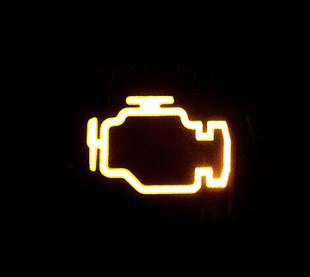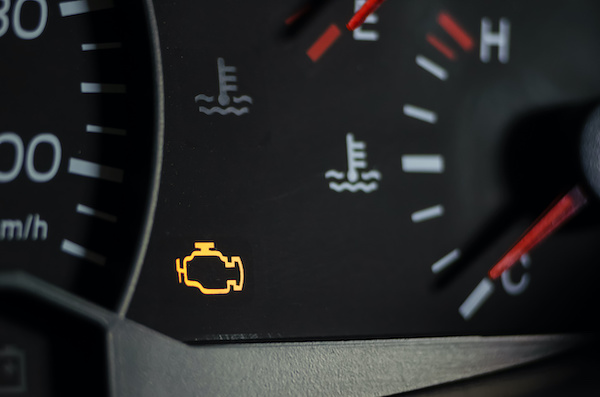A blinking check engine light indicates a severe engine misfire causing potential damage to the catalytic converter. Immediate attention from a professional mechanic is necessary to prevent further harm.
A car’s check engine light acts as a crucial indicator of its health, signaling when something under the hood requires attention. This dashboard warning can range from minor issues to critical malfunctions. When the light flashes, it’s a clear sign that your vehicle is experiencing a significant problem that needs quick diagnosis and repair.
Ignoring this alert can lead to more expensive repairs and even jeopardize your safety on the road. Understanding this urgency helps drivers maintain their vehicles more effectively and avoid the pitfalls of neglect. Regular maintenance and prompt response to such warnings keep your car running smoothly and reliably.

Credit: m.youtube.com
Blinking Check Engine Light: A Critical Alert
The Blinking Check Engine Light: A Critical Alert is a sign.
It means your car needs help fast. It’s like your car is saying, “Please fix me now!”
Immediate Actions To Take
- Stop driving your car. It’s safer this way.
- Find a safe place to pull over. This keeps you safe.
- Check your car’s manual. It has useful information.
- Call for help. A mechanic can fix your car.
Potential Risks Of Ignoring The Warning
| Risk | What It Means |
|---|---|
| More damage | Ignoring can lead to bigger, costly fixes. |
| Unsafe | Your car might not be safe to drive. |
| Costs more | Fixing big problems costs more money. |
Decoding The Flashing: Severity Levels
Decoding the Flashing: Severity Levels helps you understand your car better. A blinking check engine light can scare any driver. It’s a sign something might be wrong with your car. Let’s learn what the light means. Especially, how serious the problem could be.
Solid Vs. Flashing Indicator
Two types of check engine lights exist:
- Solid Light: This means check the car soon. But it’s not urgent.
- Flashing Light: This means check the car now. It’s urgent.
A flashing light is serious. It often means the engine is misfiring. This can harm the car’s catalytic converter. Fixing this fast saves money and trouble.
Interpreting Diagnostic Trouble Codes
Cars have a computer called OBD-II. It checks all parts of the car. When there’s a problem, OBD-II gives a code. This code tells what’s wrong. Mechanics use a tool to read this code.
Here’s how codes help:
- They make finding problems faster.
- They help understand how serious the problem is.
- They guide on how to fix the problem.
Remember, a flashing check engine light is a warning. It tells you to act fast. Understanding these signals helps keep your car safe and sound.
Common Triggers For A Blinking Engine Light
A blinking engine light can worry any car owner. This light signals something is not right. Let’s explore common reasons behind this blinking light.
Misfires And Emissions Issues
Engine misfires often cause the check engine light to blink. Misfires make the car’s engine run unevenly and can damage the vehicle over time. Emissions issues are another common trigger. Cars have systems to manage exhaust gases. When these systems fail, harmful gases might not filter out properly. This failure can turn on the blinking light.
- Misfires: Happen when the engine does not fire correctly.
- Emissions Issues: Occur when exhaust systems fail to manage gases.
Sensor Malfunctions And Faults
Sensors in your car monitor everything from engine performance to emissions. A malfunctioning sensor sends wrong data to the car’s computer. This wrong data can trigger the blinking light. Common sensors that fail include the oxygen sensor and the mass airflow sensor.
| Sensor Type | Function | Common Issues |
|---|---|---|
| Oxygen Sensor | Measures oxygen levels in exhaust gases. | Fails to provide correct data. |
| Mass Airflow Sensor | Measures the amount of air entering the engine. | Gets dirty or damaged. |
Regular checks can prevent these issues. Always pay attention to your car’s signals. A blinking light means it’s time to check your vehicle.
Diy Troubleshooting Steps
Seeing your Check Engine Light (CEL) blink can be scary. You might wonder if your car is safe to drive. Before you rush to a mechanic, try some DIY steps to understand the problem better. This guide will show you how.
Initial Inspection Tips
Start with simple checks:
- Look at the gas cap. A loose cap can cause the light to blink.
- Check for obvious leaks under the car. Fluids on the ground are a bad sign.
- Listen for strange noises when the engine runs. Clicks, taps, or hisses are clues.
- Smell for odd odors from the engine or exhaust. A burning smell is a warning.
When To Use An Obd-ii Scanner
An OBD-II scanner is a tool for deeper insight. Use it if:
- The CEL blinks but you find no issues during the initial check.
- You fixed something, like the gas cap, but the light still blinks.
- The car drives differently, even if you can’t see or smell a problem.
Here’s how to use the scanner:
- Plug the scanner into the OBD-II port under the dashboard.
- Turn the ignition on but do not start the car.
- Follow the scanner’s instructions to read the error codes.
- Search online or in your car’s manual to understand the codes.
This tool helps you know if you need a mechanic or if it’s a small issue you can fix.
Professional Diagnostic Approach
A blinking check engine light signals an urgent issue with your car.
Ignoring it can lead to severe damage.
A professional diagnostic is critical.
Mechanics use advanced tools to pinpoint problems accurately.
Benefits Of Expert Analysis
- Accurate Diagnosis: Experts identify the exact issue quickly.
- Cost Savings: Correct diagnosis prevents unnecessary repairs.
- Longevity: Proper fixes extend your car’s life.
- Safety: Resolves potentially dangerous car problems.
- Peace of Mind: Assurance that your vehicle is in good hands.
What To Expect At The Auto Shop
- Arrive and discuss symptoms with a technician.
- Technician conducts a thorough inspection.
- Advanced diagnostic tools check the car’s computer.
- Mechanic reviews error codes and tests components.
- Receive a detailed report of the findings.
- Discuss repair options and costs.
- Approve the necessary repairs.
Trust your car to professionals for engine light concerns.
They ensure your vehicle remains reliable and safe.

Credit: medium.com
Cost Implications Of Engine Repairs
A blinking check engine light signals urgent engine issues. Ignoring it can lead to costly repairs. Understanding the potential expenses involved helps car owners plan financially.
Estimating Repair Expenses
Engine repairs can vary widely in cost. Factors include the car’s make, model, and the repair’s nature. Below is a simplified approach to estimate expenses.
- Diagnostic Test: Mechanics start with this to identify problems.
- Part Costs: Prices for replacement parts differ significantly.
- Labor Charges: Mechanics charge per hour. Rates depend on location and expertise.
A table helps compare common engine issues and estimated repair costs.
| Engine Issue | Low Cost Estimate | High Cost Estimate |
|---|---|---|
| Spark Plug Replacement | $50 | $150 |
| Oxygen Sensor | $200 | $500 |
| Catalytic Converter | $900 | $2500 |
Long-term Costs Of Delayed Maintenance
Delaying engine repairs leads to higher expenses. Minor issues can become major, and costs escalate. Here’s how avoiding maintenance affects your wallet.
- Increased Damage: Small problems can damage other engine parts.
- Fuel Efficiency: A faulty engine burns more fuel, costing more money.
- Resale Value: Cars with unresolved engine issues have lower resale values.
Always address engine warnings promptly. It saves money and extends your car’s life.
Preventive Measures And Maintenance Tips
A blinking check engine light signals urgent attention. To prevent this, regular maintenance is key. Let’s explore how to keep your vehicle in top shape and avoid engine warnings.
Routine Check-ups For Vehicle Health
Your car needs regular check-ups, just like you do. These check-ups catch small issues before they grow.
- Oil Changes: Replace engine oil every 3,000 to 5,000 miles.
- Tire Pressure: Check monthly for safety and fuel efficiency.
- Brake Inspection: Get brakes checked twice a year.
- Battery Test: Test the battery once a year to avoid breakdowns.
- Fluid Levels: Check coolant, brake, and transmission fluids regularly.
Best Practices To Avoid Engine Warnings
Simple habits can keep your engine light off. Follow these best practices.
- Drive smoothly to reduce engine strain.
- Warm up the car before high-speed driving.
- Avoid heavy loads on the engine.
- Use the right fuel type for your car.
- Replace air filters as needed.
- Get professional help with warning lights.

Credit: tolimas-auto.com
Frequently Asked Questions
Can I Drive My Car With The Check Engine Light Blinking?
Driving with a blinking check engine light is not recommended. It usually indicates a severe engine misfire, which can cause damage if ignored. Seek immediate professional diagnostics and repair.
What Is The Most Common Cause Of A Flashing Check Engine Light?
A flashing check engine light commonly indicates a severe engine misfire, allowing unburned fuel to leak into the exhaust system.
Why Is My Check Engine Light Blinking And My Car Shaking?
A blinking check engine light and car shaking typically indicate a severe engine misfire, demanding immediate attention to prevent costly damage.
Why Is My Check Engine Light Flashing And My Car Sputtering?
A flashing check engine light and sputtering indicate a severe engine misfire, potentially causing damage to the catalytic converter. Immediate professional diagnosis is essential.
Conclusion
A blinking check engine light should never be ignored. It’s a clear signal that your vehicle needs immediate attention. To avoid costly repairs or potential safety hazards, schedule a diagnostic check promptly. Remember, timely intervention can save you time and money, ensuring your car’s longevity and reliability.
Drive smart, stay safe.
